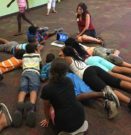Media coverage of disasters can have lasting effects on children’s mental health
University of Missouri researchers are helping teachers and parents be the first source of support to children exposed to disaster through media
December 5th, 2018
By Erica Jones
COLUMBIA, Mo. – In 2018, American children have been exposed to multiple disasters – ravaging wildfires in California, to major Hurricanes in Florida and the Carolinas, and mass shootings in schools and places of worship – all of which have been covered 24/7 by the media. Disaster communication experts at the University of Missouri say disaster media coverage can have lasting effects on children’s mental health and suggest teachers and parents be prepared to respond to questions during and after a catastrophe.
Researchers in the MU Disaster and Community Crisis Center found that teachers and parents might not be prepared to respond to students’ questions and anxieties in the aftermath of natural or human-caused disasters. The coverage can impact children’s mental health, not only in school but in response to future disasters as well.
“Teachers spend seven to eight hours a day with children,” said Jennifer First, program manager at the Disaster and Community Crisis Center and a doctoral candidate in the MU School of Social Work. “They often are the first responders, both directly and indirectly.”
The Disaster and Community Crisis Center developed a step-by-step plan with guidelines on how to discuss disasters with children. They found that teachers commonly don’t know how to answer children’s questions about disasters such as mass shootings or devastating wildfires, or explain why they happen at all.
“Images of disasters stay with kids for a long time,” First said. “That’s why it’s important to be prepared and offer helpful coping methods.”
The researchers surveyed 42 teachers on their preparation in dealing with media coverage of disasters. They also were asked what techniques they felt were needed to help students in dealing with their fears and anxieties. First and her colleagues found that many children bring concern to teachers and parents about why these terrible things happen and what can be done to stop it happening to them. The Disaster and Community Crisis Center includes instructions in their disaster intervention protocols about encouraging safety measures and helping victims. The detailed instructions can be found on their website.
“We believe that our guidelines offer a solid place for teachers and parents to learn about children’s emotions during these times,” said Brian Houston, director of the Disaster and Community Crisis Center and associate professor of communications at MU. “Children have easy access to media today, and we want to make sure they are getting the help and understanding they need when they feel unsafe or confused.”
“Student coping with the effects of disaster media coverage: a qualitative study of school staff perceptions,” was published in School Mental Health. Laura Danforth, assistant professor of social work at the University of Arkansas and graduate of MU, served as a co-author for this study.
The Disaster and Community Crisis Center at the University of Missouri focuses on enhancing preparedness, recovery, and resilience in children, families, schools, and communities affected by disaster and community crisis. Schools can request training by contact Jennifer First at firstj@missouri.edu.
Editor’s note: Jennifer First and Brian Houston provide the following advice for teachers and parents to help children deal with disasters:
- Encourage dialogue: Encourage students to talk about their feelings and concerns with a trusted adult.
- Establish a sense of safety: Promote and enhance student safety, and provide emotional comfort and support.
- Develop coping skills: Help students identify and learn coping skills.



 Photo:
Photo: